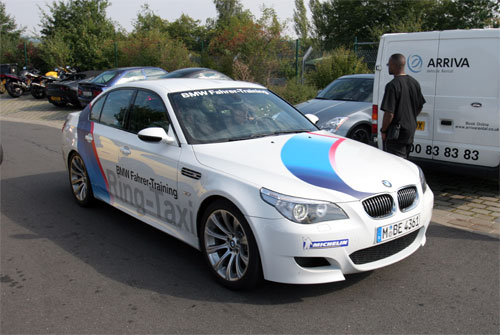October 12, 2005
The Ring
Just about every car geek who knows that cars don't just turn left all the time has heard of the Nürburgring. Most modern racetracks are anywhere from 1.5 to 3.5 miles in length, with somewhere between 8 and 15 distinct corners to memorize and incrementally perfect, lap after lap.
The Ring, by contrast, has somewhere around 170 corners spread over 14 miles. And the size is just the beginning. Its sharp changes in elevation, blind apexes, decreasing-radius turns and fast off-camber sweepers combine to provide multiple opportunities to spit the underskilled and overconfident off the track.
But the single most amazing thing about the track has nothing to do with geometry or track maps. The most amazing thing is that it's open to the public, just like a toll road.
That's right -- anyone with a drivers license and a street-legal vehicle can plunk down $15 euro for one lap. You'll see heavily-modified Porsches and BMWs, motorcycles, entire families in elderly diesel station wagons and even the occasional tour bus.

Or in my case, a tan-colored Renault Clio hatchback I rented in Paris for the occasion. With a 1.4 liter engine and skinny, 165-section tires, I wasn't going to be breaking any lap records. But it was easily fast enough to be close to the limit in the corners, which after all is the whole point of the exercise.
Starting out feels a bit like leaving a parking garage. You go to the ticket machine and feed it enough money for as many laps as you can afford. Drive up to the gate, insert the ticket, the barrier lifts, and 100 meters later, you're on the track.
The Ring operates under the standard German traffic code. In the absence of signs indicating otherwise, this means essentially the following:
- You can drive as fast as you want.
- If someone faster comes up behind you, get out of the way -- preferably to the right.
For American sensibilities, the German approach to questions of regulation, liability and personal responsibility is quite particular. For instance, strong unions and heavy government regulation businesses to operate under a wide range of constraints. It's very difficult for businesses in Germany to lay off or fire German employees, even in cases of gross incompetence. But at the Ring, the rules are just posted on the wall. There are no waivers to sign, no instruction, no pretense of "education." You're just there to drive the track, at whatever level it might please you to do so. It would never, ever be allowed in America.
True to my form, I approached the first few laps fairly cautiously, reacting more or less like I would on a public road -- at least, one with motorcycles cutting across the front of the car, two feet off the bumper. One of the biggest challenges of an open track day at the Ring is in finding the right balance between focusing on the track ahead, while keeping an eye on the mirrors to see who's behind you. The faster cars and bikes tended to come in waves; as long as you watched the mirrors enough to know when they were coming, it was ultimately pretty easy to begin to focus on the track. It's usually best to let fast-closing cars and motorcycles that you know they're there by using your right turn signal.
In the end, the track itself is well worth the trouble. The Ring's nuances have been well-documented elsewhere, and I didn't experience enough in my 15 laps to add anything useful. There is nothing else like it, and I would love to return someday with a more capable car, and enough time to actually learn the track. Maybe one of the BMW club's Nürburgring schools would do the trick.
Posted by dreeves at October 12, 2005 7:31 PM